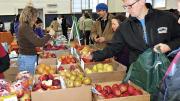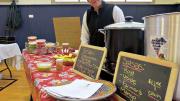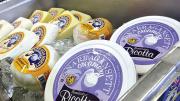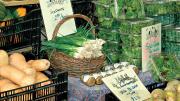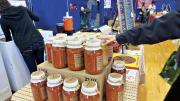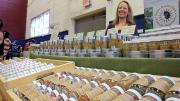The best “Frito pie” begins with only the finest local ingredients: a packet of corn chips. Chef Amanda Escamilla, of Tex Mex Eats, slits open the bag, ladles in some warm Texas chili, and tops that off with cheddar cheese and sweet onions. Grab a fork, she advises, and dig in. “Those big flavors make me feel cozy,” says the South Texas native. “Growing up, Frito pies were all over the place, at the carnival and the baseball games. It’s comfort food.” She makes and sells these addictive collations, along with fresh tamales using homemade masa (dough) steamed in corn husk wrappers, at the Cambridge Winter Farmers’ Market, which opens on January 3.
Forget dusty bins of turnips, carrots, and spuds: this market, like many others around the region, is fast moving beyond these New England staples and broadening its mission. “We favor new and small businesses with promise,” reports market manager Kim Motylewski, “and we are expanding the range of food cultures and people represented.”
This season, Tex Mex Eats and The Soup Guy are joined by Indonesian cook Nuri Auger, who serves entrées like the spicy beef rending daging, and the Jakarta-style street snacks comro and misro: fried balls of shredded cassava filled, respectively, with spicy fermented soybeans, and brown or palm sugar. These three vendors are among the two dozen who set up shop every Saturday, from 10 a.m. to 2 p.m., at the Cambridge Community Center (5 Callendar Street). “We still have root vegetables,” Motylewski assures. “But we also have greens and herbs, apples, mushrooms, meat, fish, chicken, eggs, cheese, yogurt, bread and baked goods, pasta and sauces, jams, wine, and hard cider. And ‘artsy-crafty’ people who sell things like natural bath and body-care products, and hand-made woolens.”
It’s a lively social scene. Around 600 people gather weekly to drink fresh-brewed tea and coffee, shop, have lunch, or just hang out to watch a live show. A stage features rotating performers, ranging from jazz, folk, and classical musicians to tap dancers and hula-hoopers. In a second room, the Riverside Gallery, local artwork is displayed and the market hosts free activities, including storytelling, clown acts, and natural-history programs. In early spring, the “Get Growing” festival helps people learn how to plant their own edible gardens.
Some choose to jump-start the season at home with pre-seeded herb kits compiled by Amy Hirschfeld, G ’99, owner of Soluna Garden Farm and its retail store in Winchester, Massachusetts. She and her business partner, Tatiana Brainerd, sell the one-acre farm’s fresh-cut flowers and herbs at summer markets, but have extended their year-round sales with the kits, a variety of teas, and dried-spice blends and rubs used in Moroccan, Greek, and Indian cooking. (The blends use additional organic ingredients not grown on the farm.) The idea for the business, Hirschfeld says, came from her Harvard studies of the ancient spice routes of the Arabian peninsula—her “love of traveling and good food.”
Winter markets appear to be on the rise. In Massachusetts, the move to stretch the locally grown and made food season has prompted the opening of about 40 new ones within the last four years alone, according to Martha Sweet, the director of programs and operations at the nonprofit Mass Farmers Markets, which runs popular summer markets in Cambridge, Boston, and Somerville. In addition, later this year the permanent year-round Boston Public Market is slated to open near the MBTA Haymarket station.
These off-season markets, held primarily indoors and on weekends, typically have to compete to attract local farmers. Meanwhile, the growers, increasingly, must assess whether it’s worth their time and energy to participate—and if so, how. “A lot of them are not prepared to go to winter markets, but are starting to think more about growing year-round in greenhouses, or holding their vegetables or fall fruits” for post-summer markets, explains Sweet. “Many farmers also go on vacation in the winters.”
She reports that in Massachusetts, the number of summer markets has peaked at around 250 within the last five years. “If you think about it, in a state that has 351 cities and towns, 250 farmers’ markets is a lot,” she adds. In many cases, markets that used to count on 5,000 shoppers may now see only 2,000 because there are more options now, or because they have chosen instead to join a farm’s Community Supported Agriculture food-share program. “We need to create more new shoppers,” Sweet urges, and convert the casual ones into regular customers.
Winter markets are one solution: they get people used to buying and eating local fare all the time. Subsidizing the food costs would also help. “You can go to farmers’ markets and see a lot of affluent people,” says Motylewski. “But what about everyone else? Affordability is step one.”
Last year the winter market joined local public-health officials, food-rescue organizers, and the two summer markets in Central Square and at Harvard’s Science Center Plaza (the latter run by University Dining Services), to help draw more low-income customers and increase their buying power. Those markets now have digital technology to process the debit cards distributed by the federal Supplemental Nutrition Assistance Program (SNAP). And the market organizers raise private funds through a crowd-sourcing portal to match SNAP market purchases, up to $15.
“In all these different ways,” Motylewski says, “people are coming together around different kinds of food.” At the Cambridge market, even though many customers are new to Frito pie, they know not to ingest the bag. But the tamales, says Escamilla, occasionally require a lesson. “Up here people are going at the tamale corn husk wrapper with a knife and fork, or biting into it,” she says, with a smile, “or they just suck the masa out of the corn husk like a Go-gurt we’d give our kids.” At the market, she opens the husk, and hands over the meal. But for the frozen, take-home tamales, she can only hope the package’s warning label is clear enough: “Don’t Eat the Husk!”
